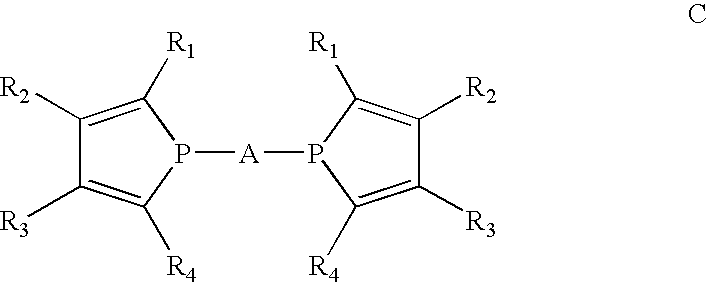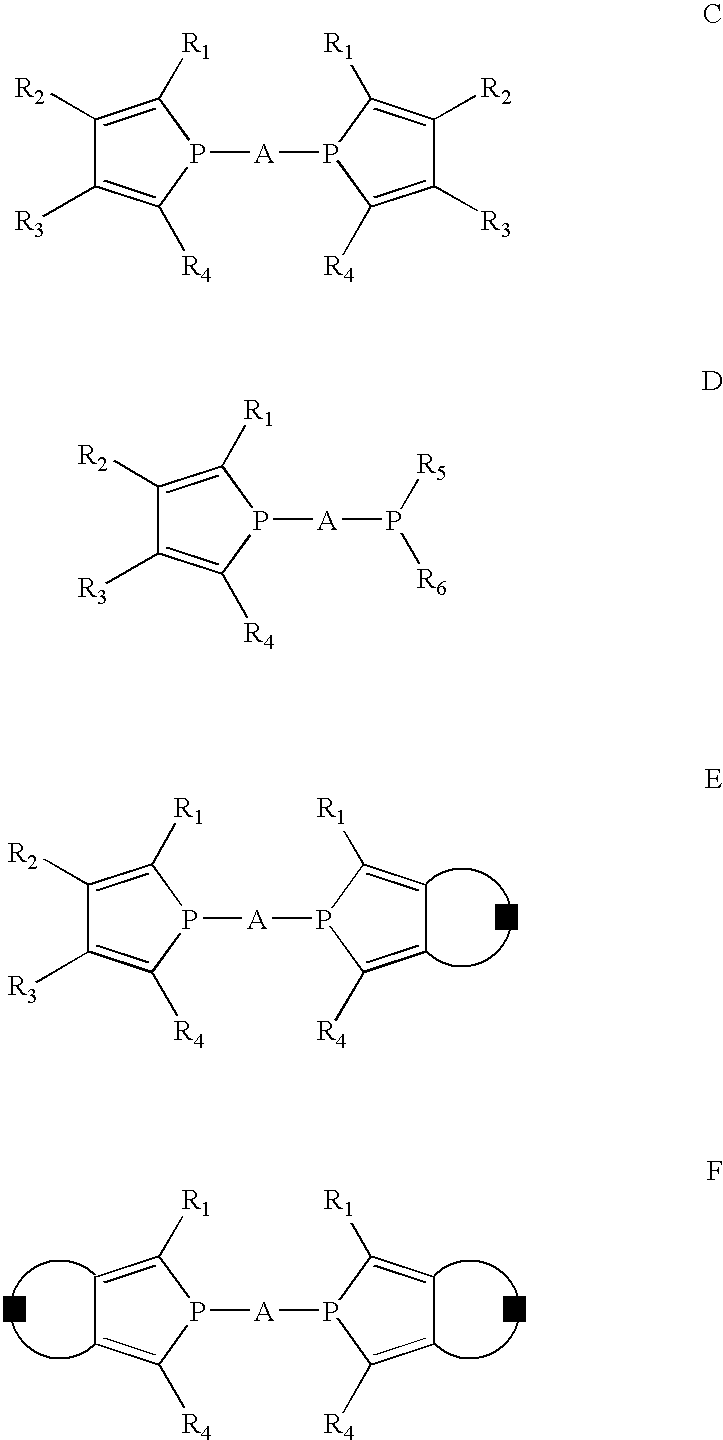Phosphole and diphosphole ligands for catalysis
a technology of phosphole and diphosphole, which is applied in the field of new phosphole and diphosphole based ligands, can solve the problems of limited application, low molecular weight of these polymers, and lack of synthetic procedures broad enough to prepare the phosphole ring system
- Summary
- Abstract
- Description
- Claims
- Application Information
AI Technical Summary
Benefits of technology
Problems solved by technology
Method used
Image
Examples
example 1
Synthesis of 1,2-bis(2,3,4,5-tetramethylphospholyl)ethane
Method A
[0072]A solution of Cp2ZrC4Me4 (2.76 g, 8.47 mmol) in CH2Cl2 (60 mL) was added dropwise to a stirring solution of 1,2-bis(dichlorophosphino)ethane (0.97 g, 4.2 mmol) in CH2Cl2 (10 mL) at room temperature over a period of 10 min, and the resulting reaction mixture was stirred for an additional 10 min before removal of the solvent under vacuum. The residue was extracted with pentane (3×70 mL) and filtered. The filtrate was dried under vacuum, and then sublimated at 130° C. / 104 Torr to afford 1.0 g (78% yield) of (C4Me4P)CH2CH2(PC4Me4).
[0073]1H NMR (300 MHz, CD2Cl2): δ 1.94 (s, 12H, 4Me), 1.91 (s, 12H, 4Me), 1.33 (s, 4H, 2CH2). 13C NMR (75 MHz, CD2Cl2): δ 143.8 (d, Jp-c=9.8 Hz), 133.2 (s), 17.0 (d, Jp-c=23.0 Hz), 14.0 (s), 13.1 (d, Jp-c=21.8 Hz). 31P NMR (12 MHz, CD2Cl2): δ 16.1 (s). Anal. Calcd for C18H28P2: C, 70.57; H, 9.21; P, 20.22. Found: C, 70.58; H, 9.02; P, 20.23.
example 2
Method B
[0074]A mixture of Cp2ZrCl2 (27.0 g, 92.5 mmol) and 2-butyne (16.0 mL, 204 mmol) in THF (150 mL) was treated dropwise with n-butyllithium (186 mmol, 1.6 M solution in hexane) at −78° C. for 10 min. The resulting reaction suspension was then allowed to stir at room temperature for 2.5 hr before cooling to 78° C. 1,2-bis(dichlorophosphino)ethane (10.7 g, 46.3 mmol) was added, the mixture was warmed to room temperature and stirred for 30 min before removal of the solvent under vacuum. The residue was extracted with pentane (3×100 mL) and filtered. The filtrate was dried under vacuum, and then sublimated at 130° C. / 104 Torr to afford 9.9 g (70% yield) of (C4Me4P)CH2CH2(PC4Me4).
example 3
Synthesis of 1,2-bis(2,3,4,5-tetraethylphospholyl)ethane
[0075]A procedure similar to that described above for 1,2-bis(2,3,4,5-tetra-methylphospholyl)ethane (Method A) above was used in synthesis of the title compound yielding 5.0 g (92% yield).
[0076]1H NMR (300 MHz, C6D6): δ 2.53 (m, 4H), 2.27 (m, 12H), 1.65 (t, J=5.7 Hz, 4H), 1.18 (t, J=7.2 Hz, 12H), 0.99 (t, J=7.5 Hz, 12H). 13C NMR (75 MHz, C6D6): δ 148.7, 142.1, 22.0 (d, Jp-c=19.4 Hz), 21.0, 17.8 (d, Jp-c=25.5 Hz), 17.1 (d, Jp-c=8.5 Hz), 15.4. 31P NMR (12 MHz, C6D6): δ 4 (s). MS (rel. abundance): M+(33), M+−Me(60), M+−Et(15), 223.2(6), 195.1(26), 167.1(14). High-resolution mass spectrum: Calcd for C26H44P2 (M+): 418.2918. Found: 418.2924. Anal. Calcd for C26H44P2: C, 70.57; H, 9.21; P, 20.22. Found: C, 74.14; H, 10.70; P, XX.
PUM
| Property | Measurement | Unit |
|---|---|---|
| temperature | aaaaa | aaaaa |
| temperature | aaaaa | aaaaa |
| temperature | aaaaa | aaaaa |
Abstract
Description
Claims
Application Information
 Login to View More
Login to View More - R&D
- Intellectual Property
- Life Sciences
- Materials
- Tech Scout
- Unparalleled Data Quality
- Higher Quality Content
- 60% Fewer Hallucinations
Browse by: Latest US Patents, China's latest patents, Technical Efficacy Thesaurus, Application Domain, Technology Topic, Popular Technical Reports.
© 2025 PatSnap. All rights reserved.Legal|Privacy policy|Modern Slavery Act Transparency Statement|Sitemap|About US| Contact US: help@patsnap.com



